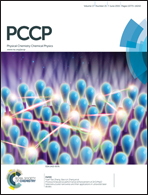Manipulating interfacial hydrogens at palladium via STM
Abstract
In this contribution, we provide a detailed dynamical analysis of the interfacial hydrogen migration mediated by scanning tunneling microscopy (STM). Contributions from the STM-current and from the non-adiabatic couplings are taken into account using only first principle models. The slight asymmetry of the tunnelling rates with respect to the potential bias sign inferred from experimental observations is reproduced by weighting the contributions of the metal acceptor–donor states for the propagation of the impinging electrons. The quasi-thermal inelastic collision mechanism is treated perturbatively. The influence of hydrogen pre-coverage is also investigated using new potential energy surfaces obtained from periodic density functional theory calculations. Fully quantum dynamical simulations of the system evolution are performed by solving the Pauli master equation, providing insight into the reaction mechanism of STM manipulation of subsurface hydrogens. It is observed that the hydrogen impurity favors resurfacing over occupation of the bulk and subsurface sites whenever possible. The present simulations give strong indication that the experimentally observed protuberances after STM-excitation are due to hydrogen accumulating in the vicinity of the surface.


 Please wait while we load your content...
Please wait while we load your content...